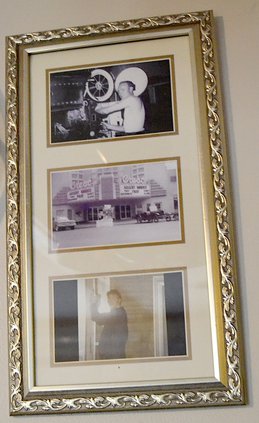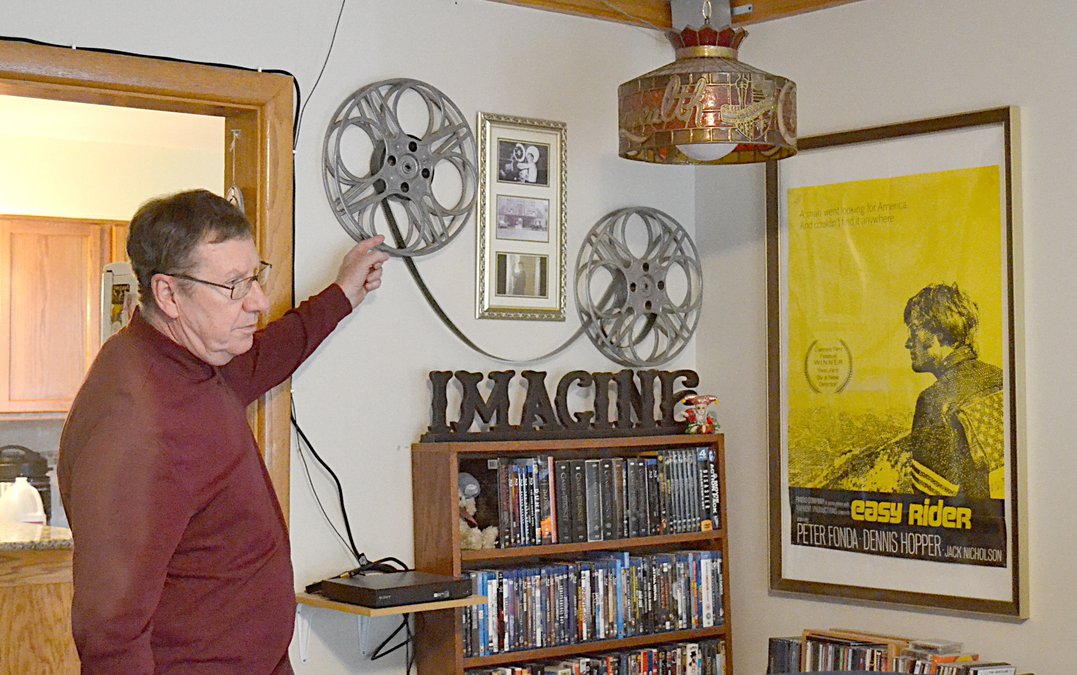In April of 1953, a Great Bend Tribune advertisement for the Great Bend Drive-In Theatre at 10th Street and Patton Road heralded, “See the Stars! Under the Stars!”
Thirty-five years ago last week, a small advertisement in the Tribune announced a final double feature at the theater, with the elaborate screen and other accompanying structures being demolished less than a year later with little fanfare.
The years in between were a golden age in the movie-going experience in Great Bend and across the country. It’s a bygone age Great Bend native Robert Marsh remembers with bittersweet fondness, because for those years, the now 71-year-old Marsh had a front row seat for an entirely different experience.
Back in Great Bend’s cinema heyday, Marsh recalls, movie-going meant more than visiting a theater and watching a film. It was an economical, yet lavish, immersing experience.
“It was family entertainment in many ways, the kind of thing you don’t get anymore,” Marsh said.
Movies in the blood
Marsh grew up with the cinema in his blood, he said. His father worked as a projectionist at the Crest Theater for over 30 years, and filled in occasionally at the drive-in. Bob worked in the industry for 25 years, and managed theaters in Great Bend, Hutchinson and Wichita for 15 years himself.
During his college years, in the summer he’d work the oilfield during the day and come to the drive-in at night to operate the projectors.
Even his 50-year marriage to his wife, JoAnn, began in the movie business. They met at the Crest Theater while his dad worked as a projectionist there.
“He kept telling JoAnn about me and she was very intrigued,” he reminisced. “First time I came home from college and I walked in, she thought, ‘okay, that’s the guy.’”
The Great Bend Drive-In
The Great Bend Drive-In was more than just a movie theater; it was a memorable family affair.
The theater had a full playground on the east side where parents could send their kids to play until the movie began. He described the drive-in’s concession stand as “a small fast food restaurant” which sold hamburgers, hot dogs, french fries and pizza along with other movie concessions staples.
“Generally, kids under 12 were free, so you just paid for mom and dad and the kids,” he recalled. “You could literally get the whole carload in for five bucks.”
Even so, he said people would go to creative lengths to be able to get a free seat at the drive-in, like sneaking people in inside the trunks of cars, and people in the adjoining housing development on Eisenhower Avenue pulling up lawn chairs to watch the movie from several hundred yards away. Residents would even try to climb fences and turn on the individual speaker poles, which transmitted sound to each vehicle, in the back row of the drive-in.
“It was almost hilarious,” he said. “It just became kind of a game.”
The drive-ins, he noted, also always played double features with an intermission, and the shows would often run until midnight or later. Even in the winter, he said, the Great Bend Drive-In would still play double features on the weekends, because he felt it would cost too much to let the theater sit idle during the winter.
The towering whitewashed structure that served as the screen for the drive-in also provided a conversation piece, as well as several memories for Marsh. Instead of being just a screen, it was a complete wood frame structure that looked like a several story building from the back, prompting people to believe the manager lived in it, he said, though that wasn’t true.
It also served as a towering traffic-control device on movie nights.
He remembered going up to the top of the structure with staff members with flashlights, and directing traffic through the busy 10th Street and Patton Road intersection, because the intersection became so congested on movie nights.
The film quality, though, was notoriously bad. Back then, movies were still on film reels. Because the Great Bend Drive-In was a second-run theater, the reels were often in poor shape by the time the drive-in got them.
This often caused havoc. He recalled a lot of unhappy moviegoers when the film would invariably break, and the projectionist would have to splice and rerun the reel.
“Everybody’s honking at you, but no pressure,” he joked.
Campy movie marathons were especially popular, especially with horror films, westerns and 1970s kung-fu movies.
The Crest Theater
The Crest, which took the place of the old Kansan Theater, was remodeled by Commonwealth Theatres to begin showing movies when Marsh was a kid in the early 1950s.
As a kid, while his dad worked as a projectionist at the Crest, Marsh said he would watch movies from the balcony, which he said was not often used for public seating while the theater showed movies.
“It was the best seat in the house,” he remembered fondly.
And movies at the Crest were a far more expansive, lavish experience than moviegoers today experience. Often, cartoon shorts and newsreels, and other short features would precede the feature films.
He recalled how at the Crest a lavish double set of curtains adorning the screen, one vertical and one horizontal, enhanced that experience. After the preceding material, and prior to the main feature film, the horizontal curtain would drop down to add to the dramatic nature of the presentation.
“The presentation at the Crest was a fancy show,” he said.
Movie promotion
As part of the experience, he said managers would resort to creative, and often outlandish, ways to promote movies, called “ballyhooing.”
“I was told one time a theater manager was one step above a carnival barker,” he joked.
The means were wild and varied, like when he drove a borrowed pink Mustang around town to promote “Pink Cadillac” (no one in town had a pink Cadillac, he said); or when he held a “car bash,” where he charged 50 cents a whack on a junk car on the patio of the drive-in’s concession stand, and donated the proceeds to the local schools; or when he invited a fortune teller to tell people’s fortunes.
The means for promoting scary movies, a drive-in staple as Marsh tells it, were even more outlandish, not family-friendly and not likely to be repeated nowadays.
“It made it fun for us as the employees, and for the customers. It was different,” he said.
He would also put posters in windows of other businesses, and then tie in with a display for that business at the theaters.
Because most towns had theaters back then – Hoisington, he recalled, had both a drive-in and an indoor theater at one time – local theater managers in the area would often try to compete and outdo each other with their displays and movie promotions.
“It’s that kind of thing that really made the drive-ins fun,” Marsh said.
So, what happened?
Eventually, the movie-going experience changed with time and technology.
Drive-ins were high maintenance propositions which required a lot of time and capital investment, especially in land and equipment upkeep. So even in the best of times, the profit margins were low.
In the end, increasing fuel prices and new technologies allowing convenient movie watching from the comfort of home drove people away from the drive-ins. And as technology at theaters improved, the expense of upgrading that equipment made it difficult for drive-ins and small single-screen indoor theaters such as the Crest to continue showing movies.
Angela Meitner, manager with the Great Bend Community Theatre, is not sure exactly when the Crest stopped showing movies, but she recalls the theater was vacant as of 1986, until the GBCT started showing plays there in 1991.
Currently, only a little over 300 drive-ins still operate in the country – fewer than 10 in Kansas – and fewer area towns have movie theaters of any kind.
“The drive-ins were a pain in many ways, but I miss them,” he said. “It wasn’t just going to a movie.”
Even today, he still doesn’t mind watching the same movie over and over again, something he did so often in the movie business.
Because the movies will always be in Bob Marsh’s blood.












